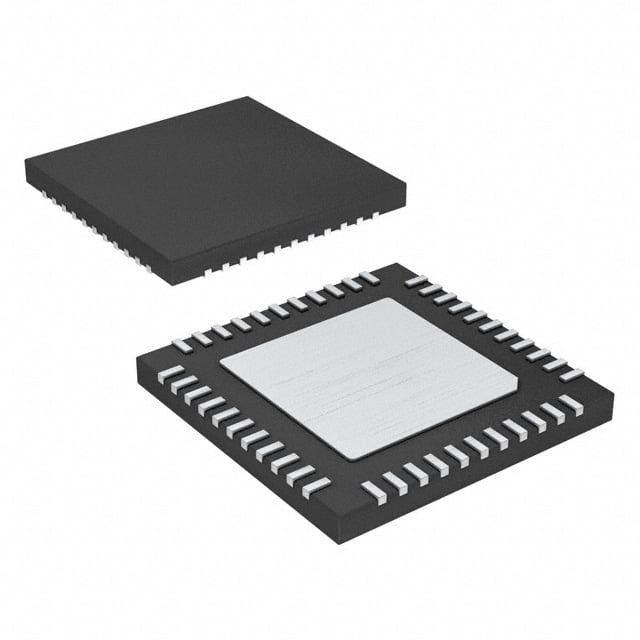Xem thông số kỹ thuật để biết chi tiết sản phẩm.

PIC24F16KM204T-I/ML
Introduction
The PIC24F16KM204T-I/ML belongs to the category of microcontrollers and is designed for a wide range of applications. This entry provides an overview of its basic information, specifications, detailed pin configuration, functional features, advantages and disadvantages, working principles, detailed application field plans, and alternative models.
Basic Information Overview
- Category: Microcontroller
- Use: Embedded control applications
- Characteristics: Low power consumption, high performance, integrated peripherals
- Package: QFN
- Essence: Efficient embedded control
- Packaging/Quantity: Tape & Reel, 490 units
Specifications
- Core: 16-bit
- Speed: Up to 16 MIPS
- Flash Memory: 16 KB
- RAM: 1 KB
- Operating Voltage: 1.8V - 3.6V
- I/O Pins: 28
- Communication Interfaces: UART, SPI, I2C
- Analog-to-Digital Converter (ADC): 10-bit, 10 channels
Detailed Pin Configuration
The detailed pin configuration includes the assignment of each pin for specific functions and interfaces. Refer to the datasheet for the complete pinout diagram.
Functional Features
- Integrated Peripherals: Timers, PWM modules, input capture, output compare
- Low-Power Modes: Sleep, idle, and doze modes for power optimization
- Peripheral Pin Select (PPS): Flexibility in mapping peripherals to I/O pins
- Enhanced Connectivity: USB, CAN, Ethernet interfaces
Advantages and Disadvantages
Advantages
- High performance with low power consumption
- Rich set of integrated peripherals
- Flexible pin mapping with PPS
- Enhanced connectivity options
Disadvantages
- Limited on-chip memory for certain applications
- Higher cost compared to some alternatives
Working Principles
The PIC24F16KM204T-I/ML operates based on the Harvard architecture, where program and data are stored in separate memory spaces. It executes instructions at high speed, making it suitable for real-time control applications.
Detailed Application Field Plans
- Industrial Control: PLCs, motor control, industrial automation
- Consumer Electronics: Home appliances, smart devices
- Automotive: Engine control, dashboard displays
- Medical Devices: Patient monitoring, diagnostic equipment
Detailed and Complete Alternative Models
- PIC24F08KM101
- PIC24F32KA304
- PIC24FJ128GA010
In conclusion, the PIC24F16KM204T-I/ML microcontroller offers high performance and flexibility for a wide range of embedded control applications. Its integrated peripherals, low-power modes, and connectivity options make it a compelling choice for various industries.
Word count: 410
Liệt kê 10 câu hỏi và câu trả lời thường gặp liên quan đến ứng dụng PIC24F16KM204T-I/ML trong giải pháp kỹ thuật
What is the maximum operating frequency of PIC24F16KM204T-I/ML?
- The maximum operating frequency of PIC24F16KM204T-I/ML is 32 MHz.
What are the key features of PIC24F16KM204T-I/ML?
- Some key features of PIC24F16KM204T-I/ML include 16 KB Flash program memory, 512 bytes of RAM, and various communication interfaces such as UART, SPI, and I2C.
Can PIC24F16KM204T-I/ML be used in battery-powered applications?
- Yes, PIC24F16KM204T-I/ML is suitable for battery-powered applications due to its low power consumption and sleep modes.
What development tools are available for programming PIC24F16KM204T-I/ML?
- Development tools such as MPLAB X IDE and MPLAB XC16 Compiler can be used for programming PIC24F16KM204T-I/ML.
Does PIC24F16KM204T-I/ML support analog-to-digital conversion?
- Yes, PIC24F16KM204T-I/ML features a 10-bit analog-to-digital converter (ADC) with multiple channels.
Is PIC24F16KM204T-I/ML suitable for motor control applications?
- Yes, PIC24F16KM204T-I/ML can be used for motor control applications due to its pulse-width modulation (PWM) outputs and general-purpose input/output (GPIO) pins.
What communication protocols does PIC24F16KM204T-I/ML support?
- PIC24F16KM204T-I/ML supports communication protocols such as UART, SPI, and I2C, making it suitable for various interfacing requirements.
Can PIC24F16KM204T-I/ML be used in industrial automation systems?
- Yes, PIC24F16KM204T-I/ML is well-suited for industrial automation systems due to its robust design and communication capabilities.
What are the available package options for PIC24F16KM204T-I/ML?
- PIC24F16KM204T-I/ML is available in a 28-pin QFN package, providing flexibility for different PCB layouts and space constraints.
Are there any application notes or reference designs available for PIC24F16KM204T-I/ML?
- Yes, Microchip provides application notes and reference designs to assist in the implementation of PIC24F16KM204T-I/ML in various technical solutions.

